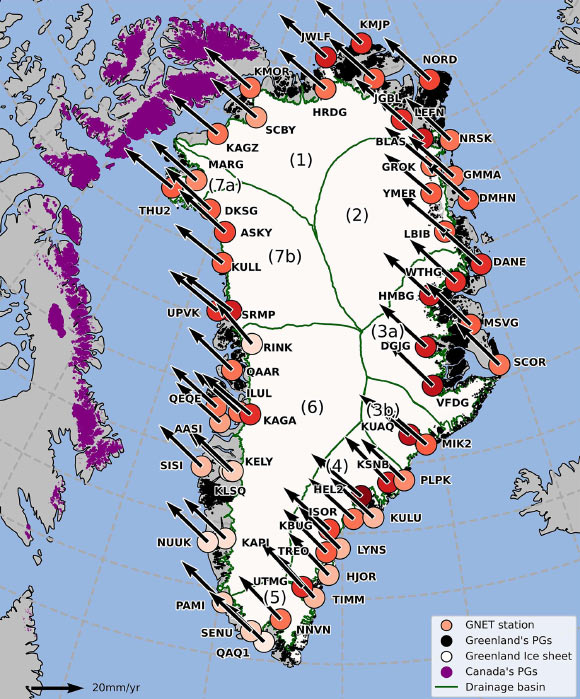This happens due to plate tectonics and movements in the bedrock, caused by the large ice sheets on top melting and reducing pressure on the subsurface, according to a new paper published in the Journal of Geophysical Research: Solid Earth. The pressure is easing both because large amounts of ice have melted in Greenland in recent years, and because the bedrock is still affected by the enormous ice masses that have melted since the peak of the last Ice Age around 20,000 years ago. As a result, the entire island has shifted northwest over the past 20 years by about 2 cm per year.

Horizontal land motion observed by the 58 GNET stations in Greenland. Image credit: Longfors Berg et al., doi: 10.1029/2024JB030847.
”Overall, this means Greenland is becoming slightly smaller, but that could change in the future with the accelerating melt we’re seeing now,” said Dr. Danjal Longfors Berg, a postdoctoral researcher at the Technical University of Denmark and NASA’s Jet Propulsion Laboratory.
“The geophysical processes affecting Greenland’s shape are pulling in different directions.”
“The ice that has melted in recent decades has pushed Greenland outward and caused uplift, so the area has actually become larger during this period.”
“At the same time, we see movement in the opposite direction, where Greenland is rising and contracting due to prehistoric changes in the ice masses related to the last Ice Age and its end.”
It is the first time the horizontal movements have been described in such detail.
“We have created a model that shows movements over a very long timescale from about 26,000 years ago to the present,” Dr. Longfors Berg said.
“At the same time, we have used very precise measurements from the past 20 years, which we use to analyze the current movements.”
“This means we can now measure the movements very accurately.”
The new measurements are based on data collected by 58 GNSS stations (GPS) placed around Greenland.
These stations measure Greenland’s overall position, elevation changes in the bedrock, and how the island is shrinking and stretching.
“There have not previously been such precise measurements of how Greenland is shifting,” Dr. Longfors Berg said.
“The assumption has been that Greenland is primarily being stretched due to the dynamics triggered by the ice melting in recent years.”
“But to our surprise, we also found large areas where Greenland is being pulled together, or shrinking, due to the movements.”
The new research provides useful information about what happens when climate change hits the Arctic with accelerating speed, as is the case in these years.
”It’s important to understand the movements of landmasses,” Dr. Longfors Berg said.
“They are of course interesting for geoscience. But they are also crucial for surveying and navigation, since even the fixed reference points in Greenland are slowly shifting.”
_____
D. Longfors Berg et al. 2025. Estimation and Attribution of Horizontal Land Motion Measured by the Greenland GNSS Network. JGR: Solid Earth 130 (9): e2024JB030847; doi: 10.1029/2024JB030847







